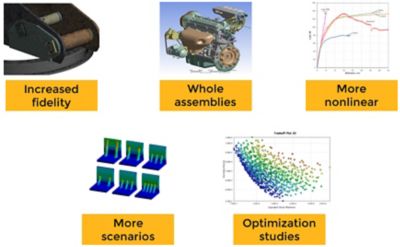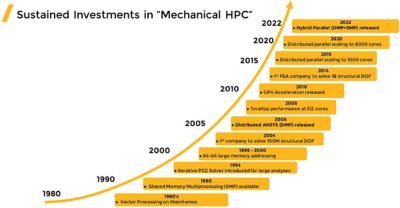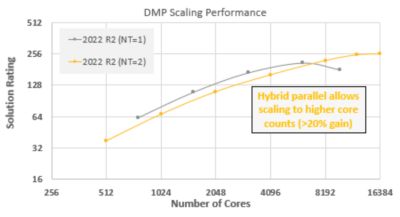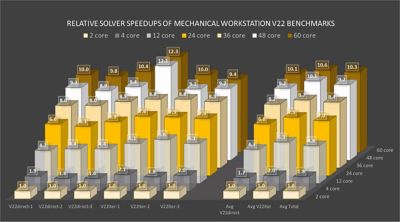-
United States -
United Kingdom -
India -
France -
Deutschland -
Italia -
日本 -
대한민국 -
中国 -
台灣
-
Ansys s'engage à préparer les étudiants d'aujourd'hui à la réussite, en leur fournissant gratuitement un logiciel de simulation.
-
Ansys s'engage à préparer les étudiants d'aujourd'hui à la réussite, en leur fournissant gratuitement un logiciel de simulation.
-
Ansys s'engage à préparer les étudiants d'aujourd'hui à la réussite, en leur fournissant gratuitement un logiciel de simulation.
-
Contactez-nous -
Carrières -
Étudiants et universitaires -
-
S'inscrire -
Déconnexion -
Espace client -
Support -
Communautés partenaires -
Contacter le service commercial
Pour les États-Unis et le Canada
+1 844.462.6797
-
ANSYS BLOG
November 29, 2022
High-Performance Computing Unlocks Next-Level FEA Performance
I’ve heard many finite element analysis (FEA) users talk about their engineering challenges. For example, many of them face increased product complexity, tighter quality requirements, and higher productivity indexes.
To enable our FEA users to cope with these challenges more efficiently, Ansys has made significant advances in high-performance computing (HPC) technologies; especially in areas of parallel, parametric, and cloud computing. How can FEA users benefit from these advances? Let’s find out.
Why HPC for FEA Simulations?
First, we will address why you would want to use HPC for FEA simulations.

HPC enables FEA users to increase the fidelity of their simulations, tackle whole assemblies, do more nonlinear analyses, evaluate more design scenarios, and conduct large scale optimization studies. All of this leads to better, faster engineering, and, more importantly, faster innovation, faster time to market, and less rework.
Although HPC stands for high-performance computing, we can’t associate it solely with supercomputers. Nowadays, you can purchase very powerful workstations and servers that can also be associated with HPC.
At Ansys, we define HPC as, an ongoing effort designed to remove computing limitations from engineers who use simulation software in all phases of design, analysis, and testing.
Hardware and software advancements go hand in hand as illustrated in our history of Ansys Mechanical HPC developments, from the 1980s with vector processing on mainframes to distributed parallel processing on an 8000-core cluster in 2020.

What’s New in HPC?
Ansys has made long-standing, sustained investments in HPC, and we have no plans to slow down. In 2022, we released hybrid parallelism in Mechanical. Apart from hybrid parallelism, we’ve also made other HPC advancements in 2022, such as optimized data storage and the implementation of a more accurate prediction method of memory requirements for Mechanical simulations. We also added support for AMD Instinct™ graphics processing unit (GPU) cards on Linux.
We introduced hybrid parallelism in Ansys 2022 R1. Hybrid parallelism is a way to blend the distributed memory parallel model with the shared memory model. In this way, we’re giving FEA users the full flexibility to maximize their performance on a workstation or on compute nodes of an HPC cluster.

As you can see in the figure below, we have continued to squeeze more scaling out of the sparse solver of our Mechanical software over the last couple of years.

In addition, Ansys has added support for the latest AMD Instinct™ MI200 Series accelerators — AMD’s data-center-class GPU family. Support for these new AMD GPUs gives Ansys customers more flexibility when choosing HPC hardware, both on-premises and in the cloud. In some cases, AMD GPU acceleration can provide speedups of as much as 8x or 14x, depending on the application. You can learn more about the Ansys and AMD partnership in this blog.
Realize 10X Faster Insight Even on a Workstation
You don’t necessarily need to run your FEA applications on an HPC cluster to achieve significantly faster times to insight. By adding two HPC Pack licenses to your solver license, you can achieve well over 8x speedup running on 36 processor cores on a dual-processor workstation. By enabling another HPC Pack license, an average 10x speedup can even be obtained as shown in the graph below.

The above V22 benchmark cases represent typical workstation usage, range in size from 3.4 million to 25 million degrees of freedom, and contain both direct (Sparse) and iterative (PCG) solver models covering a wide variety of analysis types including static, transient, modal, and nonlinear.
How to Benefit from HPC
Typically, our customers are on an HPC path or journey, starting off with Ansys on a laptop or desktop computer, or already running in the cloud.
Once the group of Ansys users grows, they usually start using more compute power with multiple servers or even clusters in a datacenter. This extra compute capacity can enable multiple, concurrent simulation jobs, and often more complicated simulations. We’ve been working with partners to come up with recommended laptop, desktop, and HPC system configurations for Mechanical applications. Visit our HPC solutions page for more info.
Cloud is clearly an emerging and ideal deployment model of HPC because it enables our customers to improve their business agility and IT efficiency. Ansys Cloud Direct, our fully managed cloud solution, provides easy and instant access to on-demand HPC in the Microsoft Azure cloud directly from within many Ansys applications. With only a few mouse clicks, mechanical engineers have the power of the cloud at their fingertips. They submit the solve portion of their mechanical analysis from within their desktop application and never need to leave the Ansys desktop environment. Alternatively, they can use virtual desktop infrastructure (VDI).
Because it is our goal to advance the experience of our customers, we are working on new cloud offerings that will enable even more complex workflows. These new cloud offerings will enable you to use your own subscription with the cloud service provider (CSP).
We’ve also just released Ansys Gateway powered by AWS, an easy-to-use cloud solution that allows customers to deploy and scale Ansys applications on a VDI or HPC cluster via the Ansys Gateway web portal. Customers can use their own AWS subscription and their own software licenses, providing greater control and scalability. You can learn more by reading this blog.
To learn more about how you can accelerate your FEA simulation using HPC, watch our on-demand webinar, 3 Ways to Speed Up Your FEA Simulations.










